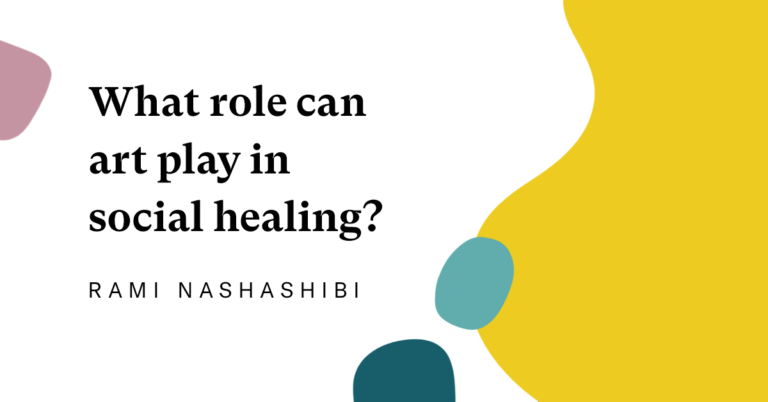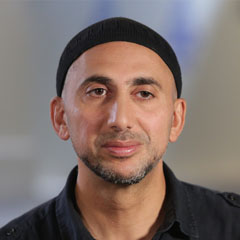Rami Nashashibi
Art and Justice Work Together
Rami Nashashibi is a champion for how art can make humans visible to each other. He brings a new energy to Islam’s core commitment to beauty and humanity — and to the power of stories to heal and electrify us across geography and generation, culture and faith. He founded the Inner-City Muslim Action Network on Chicago’s South Side, where he also lives with his family. “The arts have become the real factor for us in both humanizing each other’s stories, connecting our stories, and revealing to one another the possibilities of what a better world can look like,” he says.

© All Rights Reserved.
Guest

Rami Nashashibi is founder and executive director of the Inner-City Muslim Action Network (IMAN) in Chicago. He was named a MacArthur fellow in 2017 and an Opus Prize laureate in 2018.
Transcript
[music: “Sun Will Set” by Zoë Keating]
Krista Tippett, host: I’ve had hundreds of big conversations, and my conversation partners share wisdom I carry with me wherever I go. Rami Nashashibi fills me with hope about how art can make humans visible to each other. He brings a new energy to Islam’s core commitment to beauty and humanity — and to the power of stories to heal and electrify us across geography and generation, culture and faith. He founded the Inner-City Muslim Action Network on Chicago’s South Side, where he also lives with his family.
This is Becoming Wise. I’m Krista Tippett.
Ms. Tippett: Talk to me about how you bring the arts into what you do. Here’s one of the big defining sentences on your website — that “IMAN works for social justice, delivers a range of social services, and cultivates the arts in urban communities.” I want to hear a little bit about how spiritually and practically the arts and justice work together for you.
Rami Nashashibi: Well, for me, that tradition — and while now we host artists from the subcontinent who are performing Qawwali alongside an opera singer, along a spoken-word poet, alongside a traditional hip-hop artist. A lot of that, honestly, started with hip-hop.
Ms. Tippett: You’re really critical of people who condemn hip-hop as part of the decay of culture and ruining our young.
Mr. Nashashibi: Yeah, because I think hip-hop’s origins have been extraordinary, and that’s because there is an aspect of hip-hop culture that was extraordinary in bringing together the most disconnected, the most marginalized and disempowered sectors of urban young people, both in the Bronx and then in other urban centers and found just extraordinarily creative ways of expressing not only a search for a commonality but a common cultural experience that was both universal and particular at the same time. So you found for the first time young Latino, black, and white kids in New York coming together around a cultural creation that both allowed them to celebrate their Aztec traditions as well as their shared New York experience. That model, that formula, became global.
So the way we gravitated towards it was very organic. It became the most powerful and useful way of bringing together young kids in Chicago who were totally disconnected from one another while still living and sharing the same kind of urban experiences.
So, for example, one of our first projects we did was on one big side of the wall where there was a well-known graff writer — and graffiti writing is one of the four elements of hip-hop in Chicago. His name was ZORE, a Puerto Rican guy. I got a hold of him, and I showed ZORE traditional Islamic calligraphy. There’s a verse in the Qur’an that some people have heard. It’s, ‘we created you into nations and tribes so that you may get to know one another, not hate one another,’ and that ‘the most dignified among you is the one with the most consciousness of the divine.’
We used that verse. I showed him traditional Islamic calligraphy and it was done in this really ornate, circular style. And he said, “Let’s throw that up on the wall.” And I said, “Yeah, that’d be great.” He said, “But I’m going to make it contextually relevant to urban graffiti.” I said, “That’s fine. You can do whatever you want, ZORE, as long as you retain the core elements of this piece.” And he said, “That’s fine, and it’s speaking to me. I see this piece. It’s speaking to me.”
I remember what we did was, literally, we gathered over 250 kids in the neighborhood, and we had this unveiling of it that brought these hip-hop artists together. It was both something that connected; it was relevant; it celebrated a core aspect of Muslim tradition. We saw the power — and that was as early as 1995. Since then, we’ve used the art as a way to tell our stories, as a way to connect our stories. The arts have become the real factor for us in both humanizing each other’s stories, connecting our stories, and, I think, revealing to one another the possibilities of what a better world can look like.
[music: “Sun Will Set” by Zoë Keating]
Ms. Tippett: Rami Nashashibi was named a MacArthur fellow in 2017 and an Opus Prize laureate in 2018.
Becoming Wise is produced by Marie Sambilay, Lily Percy, and Chris Heagle at On Being Studios, which is located on Dakota land. And our theme music is provided and composed by Zoë Keating.







Reflections